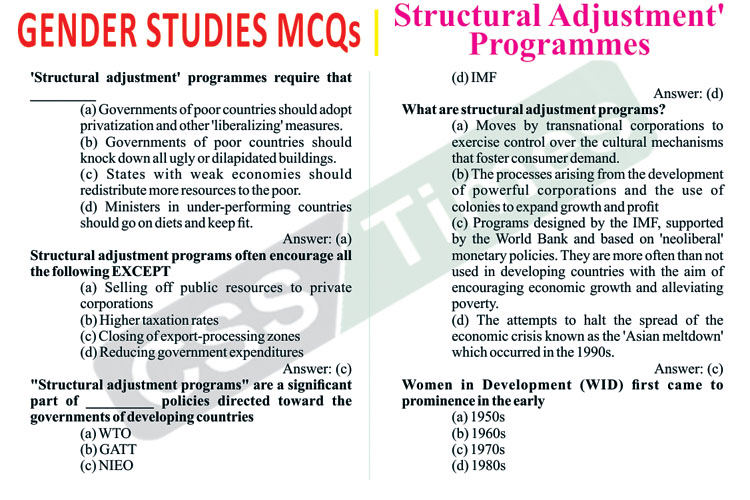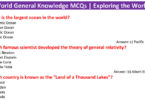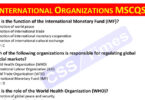Gender Studies MCQS
Structural Adjustment’ Programmes
‘Structural adjustment’ programmes require that _________
(a) Governments of poor countries should adopt privatization and other ‘liberalizing’ measures.
(b) Governments of poor countries should knock down all ugly or dilapidated buildings.
(c) States with weak economies should redistribute more resources to the poor.
(d) Ministers in under-performing countries should go on diets and keep fit.
Answer: (a)
Structural adjustment programs often encourage all the following EXCEPT
(a) Selling off public resources to private corporations
(b) Higher taxation rates
(c) Closing of export-processing zones
(d) Reducing government expenditures
(e) Charging citizens more for government services
Answer: (c)
World-system theory has a _________ orientation
(a) Marxist
(a) capitalist
(a) Mercantilist
(a) Neo-functionalist
(a) Constructivist
Answer: (a)
What are structural adjustment programs?
(a) Moves by transnational corporations to exercise control over the cultural mechanisms that foster consumer demand.
(b) The processes arising from the development of powerful corporations and the use of colonies to expand growth and profit
(c) Programs designed by the IMF, supported by the World Bank and based on ‘neoliberal’ monetary policies. They are more often than not used in developing countries with the aim of encouraging economic growth and alleviating poverty.
(d) The attempts to halt the spread of the economic crisis known as the ‘Asian meltdown’ which occurred in the 1990s.
Answer: (c)
Women in Development (WID) first came to prominence in the early
(a) 1950s
(b) 1960s
(c) 1970s
(d) 1980s
Answer (c)
The Gender and/in Development (GAD or GID) perspective emerged in the late
(a) 1960s
(b) 1970s
(c) 1980s
(d) None of these
Answer (c)
UN Decade for Women
(a) 1965-75
(b) 1975-85
(c) 1955-65
(d) None of these
Answer (b)
The Gender and Development (GAD) approach was developed as a response to the failure of
(a) UN Polices
(b) WID projects
(c) The effectiveness approach
(d) None of these
Answer (b)
_________ 57% of HIV infected individuals are women
(a) Asia
(b) Africa
(c) South America
(d) None of these
Answer (b)
Women make up the _________ of individuals living in poverty
(a) 70%
(b) 60%
(c) 66%
(d) 65%
Answer (a)
_________ was able to distinguish the difference between sex and gender in 1972
(a) Richard Titmuss
(b) Ann Oakley
(c) Laura Lamson
(d) None of these
Answer (b)
The concept of gender was first developed by
(a) Jill Matthews
(b) Judith Butler
(c) Simone de Beauvior
(d) None of these
Answer (a)
“The male body and the female body have quite different social value and significance and cannot but help have a marked effect on male and female consciousness”. Who made this statement?
(a) Judith Butler
(b) Ann Oakley
(c) Movia Gatens
(d) None of these
Answer (c)
Explanation:
Women in development (WID) approach, was originated as a result of
(a) First feminist waves
(b) Second feminist waves
(c) Third feminist waves
(d) All of the above
Answer (d)
The first wave also known as women’s suffrage movement, originated in the
(a) South America
(b) Europe
(c) North America
(d) None of these
Answer (c)
“sex / gender distinction suggests a radical discontinuity between sexed bodies and culturally constructed gender” Who made this statement?
(a) Moira Gatens
(b) Judith Butler
(c) Ann Oakley
(d) None of these
Answer (b)
Social assistance or the “welfare approach” originated back 1950s to the 1970s during the era of decolonization and political transitioning in most African and _________ countries.
(a) European
(b) Asian
(c) South American
(d) None of these
Answer (b)
The UN organized the first global conference on women back in 1975 at
(a) Brazil
(b) Mexico
(c) China
(d) Canada
Answer (b)
The third was influenced by Ester Boserup (1970) publication on
(a) “Women’s Role in Political Life or Civic life”
(b) “Women’s Role in Economic Development”.
(c) “Women’s Role in Political Democracy”
(d) None of these
Answer (b)
In _________, the US congress implemented a bill, which required the USAID to include women in development programs.
(a) 1969
(b) 1970
(c) 1971
(d) 1973
Answer (d)
The Gender and development approach originated in the 1980s by.
(a) Radical feminism
(b) Socialist feminism
(c) Liberal feminism
(d) None of these
Answer (b)
Women for a New Era (DAWN) network, program was then officially recognized in 1986 during the 3rd UN conference on women in
(a) Mexico city
(b) Copenhagen
(c) Nairobi.
(d) Beijing
Answer (c)
The Effectiveness Approach (EA) originated in the
(a) 1950s.
(b) 1970s.
(c) 1980s.
(d) 1990s.
Answer (c)
“Structural adjustment” is the name given to a set of “free market” economic policy reforms imposed on developing countries by
(a) Bretton Woods institutions
(b) World Bank
(c) International Monetary Fund
(d) All of the above
Answer (b)
SAPs were developed in the early
(a) 1970s
(b) 1980s
(c) 1960s
(d) None of these
Answer (b)
SAPs promote
(a) Export- oriented crops
(b) Export handmade or vintage items
(c) Women’s Beauty Products
(d) None of these
Answer (a)
The poor majorities living in the
(a) South Asia
(b) South America
(c) Central Asia
(d) Developing countries
Answer (d)
Women are _________ of the world’s population
(a) one third
(b) Half
(c) one fourth
(d) None of these
Answer (b)
Structural Adjustment requires the increase and promotion of.
(a) Investment
(b) Products for exports
(c) Promotion of. Imports
(d) None of these
Answer (b)
Structural adjustment and stabilization policies (SAPs) undertaken in developing countries to receive condition-based loans from
(a) World Bank/IMF
(b) BRICS
(c) Developed countries
(d) None of these
Answer (a)
World approved an operational policy on gender in
(a) 1990
(b) 1992
(c) 1996
(d) 1994
Answer (d)
World Bank set up an external gender consultative group (EGCG) composed of
(a) 14 members
(b) 21 member
(c) 10 members
(d) 17 members
Answer (a)







